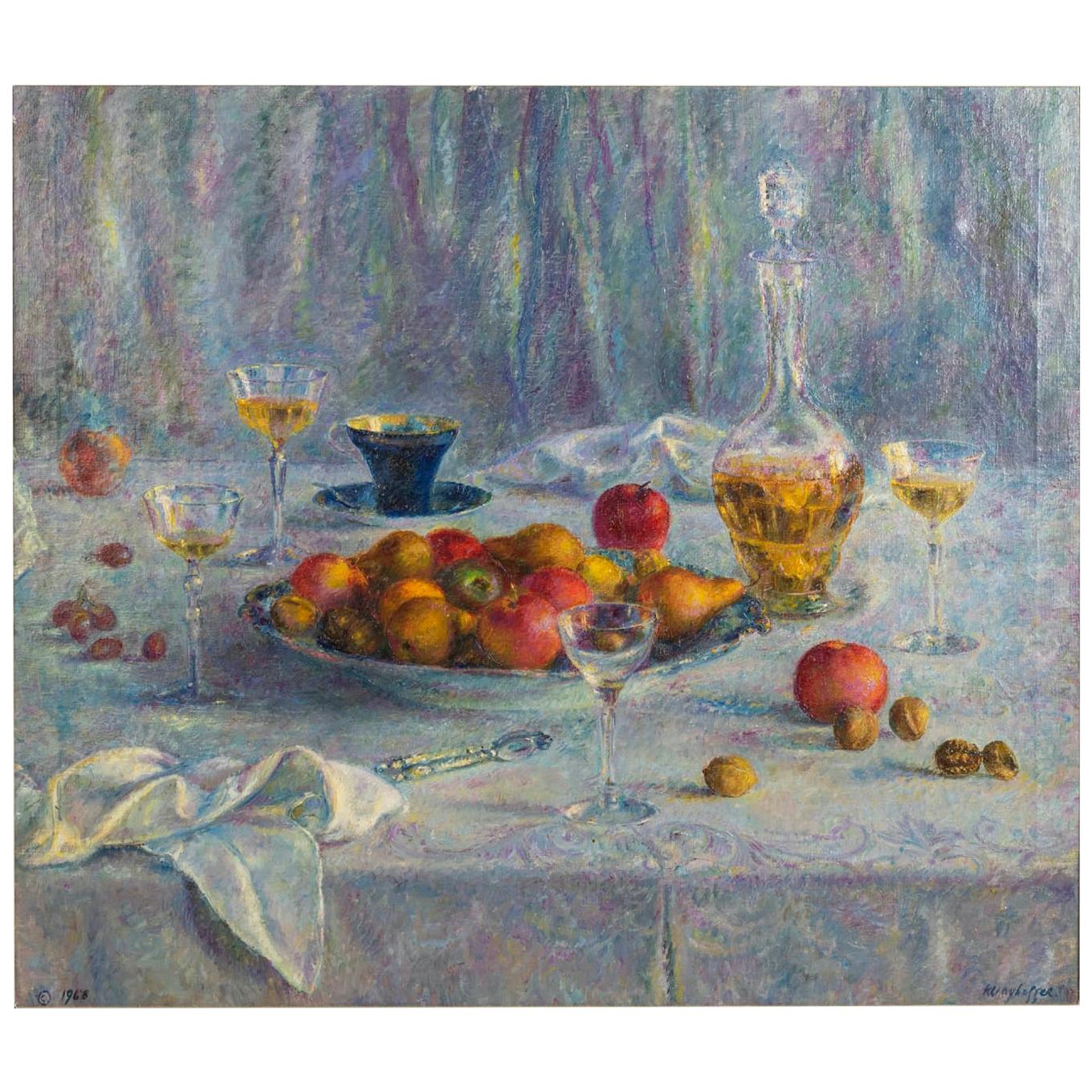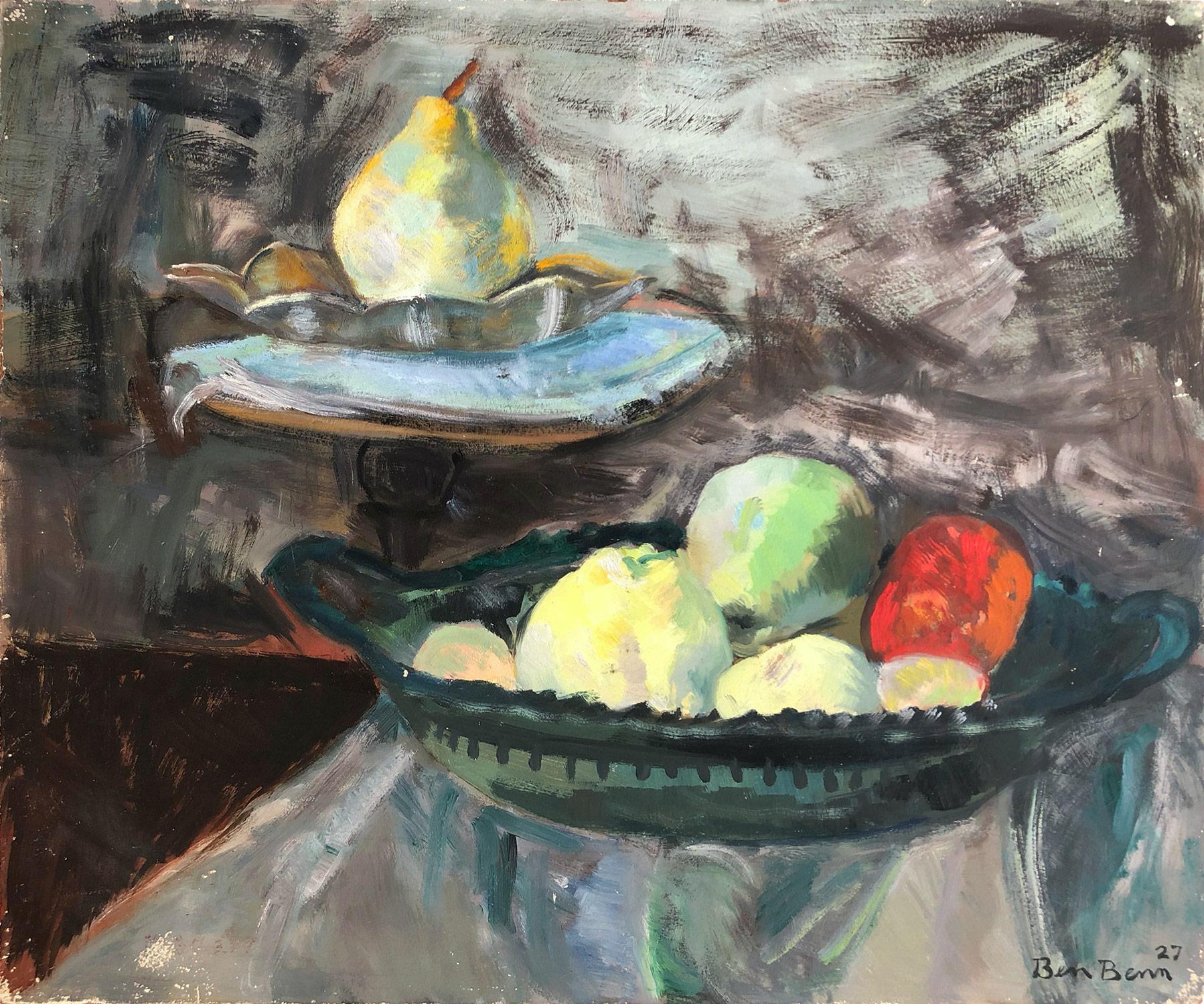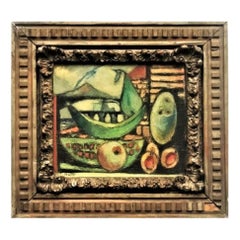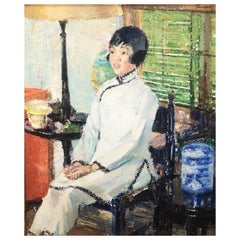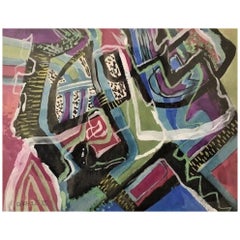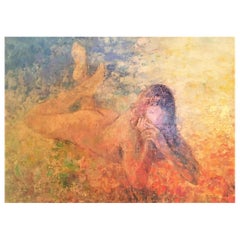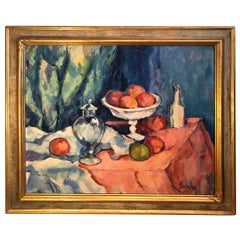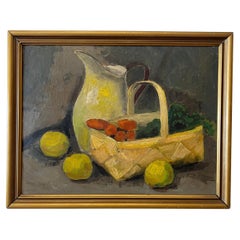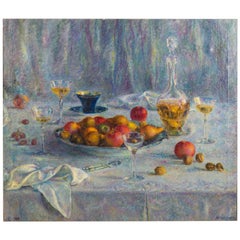Items Similar to Ivan Olinsky, Still Life w/ Chinese Porcelain Figurine & Fruits, O/C Painting, C
Want more images or videos?
Request additional images or videos from the seller
1 of 7
Ivan Olinsky, Still Life w/ Chinese Porcelain Figurine & Fruits, O/C Painting, C
$3,500
£2,687.66
€3,083.17
CA$4,917.91
A$5,507.75
CHF 2,873.85
MX$67,274.79
NOK 36,563.78
SEK 34,465.74
DKK 23,009.35
About the Item
Artist: Ivan Grigorewitch Olinsky (Russian-American, 1878 1962)
Subject: Still life w/ Chinese porcelain figurine & fruits
Period: 1920’s
Medium: Oil on canvas, framed
Signature: Signed 'Ivan Olinsky’ lower right
Dimensions: H: 16”, W: 19.75”
Ivan Grigorievich Olinsky (b. Elizabethgrad, Russia 1878 – d. New York City 1962), painter and teacher, he studied with J. Alden Weir, George W. Maynard and Robert Vannoh at the National Academy of Design in New York. His figure paintings, academic in style and influenced to a degree by Impressionism, were shown frequently at the Macbeth Gallery and Grand Central Galleries in New York City.
Joan Stahl American Artists in Photographic Portraits from the Peter A. Juley & Son Collection (Washington, D.C. and Mineola, New York: National Museum of American Art and Dover Publications, Inc., 1995)
Ivan Olinsky came to the United States from Russia when he was thirteen years old. His family settled in New York City, and several years later Ivan entered the National Academy of Design. He excelled at mural painting, and in 1900 the prominent artist John La Farge hired him as an assistant. For the next eight years Olinskys own work took a backseat to this role. As he turned thirty, he longed to establish himself as a serious artist in his own right, and he moved with his wife and daughter to Italy so that he could concentrate on his career.
When he returned to New York in 1910, critics praised his new work and the distinguished Macbeth Gallery agreed to represent him. From that time on Olinsky built a successful career as a portraitist, and his idealized paintings of women were especially popular. (Cummings, Olinsky, Faces of Change: The Art of Ivan G. Olinsky, 1878–1962)
- Creator:Ivan Grigorievich Olinsky (Artist)
- Dimensions:Height: 16 in (40.64 cm)Width: 19.75 in (50.17 cm)Depth: 2 in (5.08 cm)
- Style:Expressionist (Of the Period)
- Materials and Techniques:
- Place of Origin:
- Period:
- Date of Manufacture:circa 1920s
- Condition:Wear consistent with age and use. We make our best effort to provide a fair and descriptive condition report. Please examine photos attentively, as they are part of the description. Send us a message to request more details or discuss price.
- Seller Location:New York, NY
- Reference Number:1stDibs: LU2819323260022
About the Seller
5.0
Gold Seller
Premium sellers maintaining a 4.3+ rating and 24-hour response times
Established in 1993
1stDibs seller since 2017
83 sales on 1stDibs
Typical response time: 14 hours
- ShippingRetrieving quote...Shipping from: New York, NY
- Return Policy
Authenticity Guarantee
In the unlikely event there’s an issue with an item’s authenticity, contact us within 1 year for a full refund. DetailsMoney-Back Guarantee
If your item is not as described, is damaged in transit, or does not arrive, contact us within 7 days for a full refund. Details24-Hour Cancellation
You have a 24-hour grace period in which to reconsider your purchase, with no questions asked.Vetted Professional Sellers
Our world-class sellers must adhere to strict standards for service and quality, maintaining the integrity of our listings.Price-Match Guarantee
If you find that a seller listed the same item for a lower price elsewhere, we’ll match it.Trusted Global Delivery
Our best-in-class carrier network provides specialized shipping options worldwide, including custom delivery.More From This Seller
View AllNicolas Issaiev, Still Life with Fruits, Original Oil Painting, Ca. 1920’s
By Nikolai Alexandrovich Isaev
Located in New York, NY
Nicolas Issaiev (a/k/a Nikolai Alexandrovich Isaev, Russian-French, 1891-1977) was a painter, graphic artist, set designer, illustrator.
In the early 1900s he studied in art scho...
Category
Vintage 1920s French Expressionist Paintings
Materials
Canvas
David Anthony Tauszky, Portrait of a Chinese Woman, American Art Deco, ca. 1920s
Located in New York, NY
Dimensions: Height: 24” (61cm) Width: 20” (50.8cm) Frame width: 3.25” (8.12 cm)
About:
This very elegant painting is a part of the famous ‘Cantonese’ series of mainly female portraits, painter by David Anthony Tauszky...
Category
Vintage 1920s American Art Deco Paintings
Materials
Paint
Rolph Scarlett, Modernist Abstract Composition, Guache on Paper, Ca. 1950’s
By Rolph Scarlett
Located in New York, NY
Artist: Rolph Scarletti (Canadian, 1889 – 1984)
Object: Modernist Abstract Composition
Period: Ca. 1950’s
Medium: Guache on paper, framed
Dimensions (unframed):
Height: 9-1/3”
Width: 12”
Dimensions (framed):
Height: 22-3/4””
Width: 25-3/4”
Rolph Scarlett (Canadian, 1889 – 1984) was a consummate explorer of twentieth-century abstract painting. Never afraid of trying new styles, curious and opinionated, constantly engaged with the world around him while steadfastly aware that he was on his own path and his alone, Scarlett more than once proved to be at the artistic zeitgeist of the eras in which he lived. Exposed very early on to the work of Paul Klee through a chance meeting in Europe with the artist himself, Scarlett took up abstraction with a fervor that never diminished during his long and impressive career. To create something that had never existed before: this was Scarlett’s great cause. And that is what is most obvious when you look at Scarlett’s work—you have never seen anything quite like it.
Scarlett was Canadian-born, came of age in the Midwest, and spent few important years in Hollywood, where he designed stage sets. His work from this early period echoes Klee’s use of color, his confidence in naïve, primitive forms, and his blend of abstraction and figuration. In its flat spatial qualities it prefigures the Indian Space painting of the 1940s by a decade. He moved to New York in 1933 and eventually found his first great patron at the Museum of Non-Objective Painting, directed by Baroness Hilla Rebay and art patron Solomon R. Guggenheim. Guggenheim would collect over 60 works by Scarlett for his collection, more than any other artist outside of Vasily Kandinsky and Rudolf Bauer.
As a frequent exhibitor and lecturer at the Museum of Non-Objective Painting (MNOP), Scarlett honed his sensitive feel for bodies in space and capitalized on his trademark use of bright, vivacious colors into accomplished, perfectly harmonized geometric works. However, Scarlett soon morphed these hard-edged forms into a nuanced expressionistic abstraction which, at its best, seems to be populated by dancing forms that animate the canvases. Along this way he was advised by Rudolf Bauer, the German expatriate and one of the originators of non-objective painting in the teens. Bauer had the idea for the Museum, and Rebay, his champion, had found in Solomon Guggenheim a patron for manifesting it. When Bauer emigrated just before World War II, he wanted to meet Scarlett. The two became friends, and Bauer advised Scarlett on his work over the course of many years. Even in a 1979 interview, Scarlett began to tear up as he recalled his first meeting with Bauer, a man whose work he "worshipped," describing that, "It was a touching moment for me, I’ll tell you."
Scarlett and Rebay also had a close, important relationship, one in which he bore the brunt of her sometimes condescending, if motherly, critiques and admonitions with tolerance and gratefulness. Eventually, though, he had to push back. In a letter from 1951 he writes, "I have noticed with growing amazement that during the past three years you have accepted less and less of my work—and, that same work, which you rejected has been accepted and shown in the best and largest shows all over this country."
This period—the late 1940s to the early 1950s—did in fact correspond to Scarlett’s most critical success, and to a return to the fanciful forms and characters of his pre-war work. At the same time, he found his own rhythm and complexity using a drip style similar to, though denser and more opaque than, the one made famous by Jackson Pollock, who had worked for many years at the MNOP and with whom he shared common influences. In 1949 he had a very well received solo show in 1949 at the Jacques Seligmann Gallery, reviewed very favorably in The New York Times: "The impression made by these paintings is one of originality and strength." He was also included in a juried show "American Painting Today" at the Metropolitan Museum of Art in 1950 and in the Whitney Annual of 1951. The curator for the Whitney show in fact bypassed a selection of Scarlett’s careful geometrics in favor of a new "lyrical" drip painting—one which he describes as having had "a helluva good time" making.
Rebay articulated her loss of control over Scarlett very keenly in one of her last official letters to him: "So your way ended in the horrid jungle it is in now; even a Mr. Pollock’s smearage was not bad enough for you to have a try at; and betraying yourself, you betrayed art and my faith in you, and my present disgrace by my failure to foresee such an outrageous possibility—since you even paint objectively now."
Yet, despite the fact that he was moving in his own direction when the change in leadership took place at the Museum of Non-Objective Painting and Rebay was forced out as director, Scarlett was hit hard. He understood this change rightly as a betrayal by the establishment. Scarlett was a unique individual and soul, and was affected personally and philosophically by the idea that the movement with which Scarlett had aligned his talents seemed to disappear overnight, and his life’s work rendered valueless.
Without the Museum’s support, Scarlett decided eventually to move to the artists’ community of Shady, New York, just outside of Woodstock. He had occasional shows throughout the years, but mostly settled down to regional obscurity. He began making jewelry, which had been his first trade, and it was following a show of his jewelry in 1975 at the Jaro Gallery, that he was rediscovered by Samuel Esses, and his wife Sandy.
Samuel Esses was a successful businessman and an avid collector. He always sought out that which was unusual and, like Scarlett, was ahead of his time in many ways. For example, in 1979, Sam became enthralled with the early graffiti appearing on the New York subway trains. With the sole goal of preserving these groundbreaking yet short lived works of art he was inspired to create "The Esses Studio," a painting warehouse and workshop for graffiti artists to work in a studio, collaborate, and paint on canvas. The biggest names of graffiti writing participated—Futura, Crash, Dondi, Zephyr, and Daze to name a few. The project was well received and provided critical validation at an important time for this alternative form of abstraction to be recognized by the established art world. The success of the "Esses Studio" helped fuel an alternative fire that would propel gallerists and curators to acknowledge other street artists and provide a foundation of acceptance for the early careers of Keith Haring and Jean-Michel Basquiat. It is not a stretch to say that what Esses saw in the graffiti art of the 1970s was very similar to what he saw in 1950s-era Scarletts—something raw, honest, and melding many twentieth century influences into one unique form. Inspired by the importance of the collection and the passion of the collector, Weinstein Gallery...
Category
Vintage 1950s Canadian Mid-Century Modern Paintings
Materials
Paper
Bernard Taurelle, Nu, French Modernist Oil on Canvas Painting, circa 1960s
By Bernard Taurelle
Located in New York, NY
Signed lower right corner.
Stamped en verso Galerie Felix Vercel Paris - New York.
Original period frame.
Bernard Taurelle (French, B. 1931) is a famous French artist, widely known ...
Category
Vintage 1960s French Post-Modern Paintings
Materials
Canvas
Irina Shtenberg, Portrait of a Young Woman, Watercolor on Paper, circa 1940s
Located in New York, NY
Unsigned.
Attributed to Irina Valeryanovna Shtenberg.
Period frame.
Dimensions (unframed): Height: 13”, width: 11”
Dimensions (framed): Height: 15”, width: 12-7/8”
All the w...
Category
Vintage 1940s Russian Mid-Century Modern Paintings
Materials
Paper
Boris Solotareff, Portrait of Mr. Lautenberg, Oil on Canvas Painting, 1920s
By Boris Solotareff
Located in New York, NY
Signed en verso B. Solotareff, Lautenberg.
Original period frame, made personally by the artist.
Dimensions (without frame):
Height 16”
Width 12 ½”.
Dimensions (with frame...
Category
Vintage 1920s French Art Deco Paintings
Materials
Canvas
You May Also Like
Fruit Still Life on Board attributed to William Federick Timmons
Located in Redding, CT
Fruit still life on board signed Timmons. Attributed to William Federick Timmons(1915-1985) . Rich colors of blue, red and pink make up this fruit still life composition.
The composition consists of fruit in a pedestal bowl and the detailed drapes in the background. Custom framed. This item can parcel ship for $45.
William Frederick Timmins was born May 23, 1915 in Chicago, Illinois.
His father, Harry L. Timmins (1887-1963), was a celebrated magazine illustrator and co-owner with Frank H. Young (1888-1964) of a successful Chicago advertising agency called Young & Timmins Advertising Illustration Studios. In 1923 Timmins and Young co-founded the American Academy of Art in Chicago. His father's impressive career brought the family a prosperous and privileged lifestyle, which included pleasure trips to Paris and London.
In 1934 he began to commute by Metro North train to New York City, where he studied at the Art Students League on West 57th Street. He also took classes at the National Academy of Design on Fifth Avenue near 89th Street.
In 1935 he began to study at the Grand Central School of Art, located on the sky-lit top floor of Grand Central Station Terminal. This was the same station he used for his daily commute.
In 1935 he began to sell pen and ink story illustrations as well as painted covers to NYC publishers of pulp magazines. During the second half of the 1930s his work appeared in Western Story, Dime Sports, Clues Detective Stories, Thrilling Western, and All Aces Magazine.
He and his wife moved to a home on Spectacle Lane in Wilton, CT. This area of Connecticut had become a popular artist community. He socialized with several artist neighbors, such as Benjamin Kimberly Prins (1902-1980), Tom Lovell (1909-1997), Richard Lyon (1913-2002), Al Parker (1906-1985), Rolf Klep (1904-1981), R. G. Harris (1911-2007).
During the 1940s his cover illustrations appeared on pulp magazines, such as The Shadow, Clues Detective Stories, Wild West Weekly, and Astounding Science Fiction. All these were published by Street & Smith.
In 1944 the family moved to Darien, CT. At first the artist worked in a rented studio in nearby Norwalk, CT, but after a while he converted a vacant family room into an art studio and worked at home. After the war he drew story illustrations for Family Circle and Liberty Magazine.
In 1948 his father, Harry L. Timmins, and his brother, Harry L. Timmins, Jr., moved to California to open a lithography business in Hollywood.
During the 1950s he illustrated several books for children that were published by Rand McNally, such as Cowboys, Davy Crockett...
Category
Early 20th Century Mid-Century Modern Paintings
Materials
Wood, Masonite, Paint
$1,800 Sale Price
28% Off
Early 20th-Century "Still Life With Fruits" oil painting by Carl Fischer, Framed
By Carl Fischer
Located in Black Rock, CT
This early 20th-century still life oil painting on board by Carl Fischer captures a warm, impressionistic composition featuring a rustic woven basket of vegetables, bright citrus, an...
Category
Early 20th Century Danish Paintings
Materials
Paint
Still life with fruits. 1930, oil on canvas, 64x56 cm
Located in Riga, LV
Still life with fruits. 1930, oil on canvas, 64x56 cm
Alfons Mihailovskis (1899. 29. 03. Riga - 1966. 27. 12. Nothingem, England)
He graduated the Art Academy of Latvia, master clas...
Category
1930s Realist Still-life Paintings
Materials
Canvas, Oil
$1,702 Sale Price
20% Off
Clara Klinghoffer Still Life of Fruit Set Upon a Table, Oil on Canvas
By Clara Klinghoffer
Located in West Palm Beach, FL
Clara Klinghoffer (1900-1972)
Still life of fruit set upon a table.
Oil on canvas
Signed Klinghoffer, lower right, dated 1969, lower left.
Size with frame
Height 36.5 in. (92.71...
Category
Antique Early 1900s Paintings
Materials
Canvas
"Still Life with Fruits" Russian-American Modern Colorful Oil Painting on Board
By Ben Benn
Located in New York, NY
A strong modernist oil painting depicted in 1927 by Russian-American painter Ben Benn. With a highly recognizable modern style, fast brush stroke and expressive use of color, shape, ...
Category
1920s American Modern Still-life Paintings
Materials
Oil, Board
"Still Life with Fruits", Large, Early 20th Century Oil on Canvas by Celso Lagar
By Celso Lagar
Located in Madrid, ES
CELSO LAGAR
Spanish, 1891 - 1966
STILL LIFE OF FRUITS
signed "Lagar" lower left
oil on canvas
29-3/4 x 38 inches (75 x 96 cm.)
framed: 33-1/2 x 41-3/4 inches (84.5 x 105.5 cm.)
PROVENANCE
Private French Collector
Celso Lagar Arroyo (Ciudad Rodrigo, 1891 - Seville, 1966) was an expressionist Spanish painter of the first generation of the School of Paris, where he lived most of his life. He was influenced by avant-gardes of all kinds, such as cubism and fovism. He painted mainly landscapes and still lifes...
Category
Early 20th Century Expressionist Still-life Paintings
Materials
Canvas, Oil


